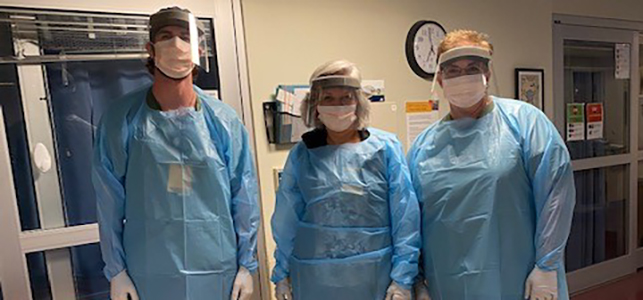
Respiratory therapy: Essential care for kids with breathing woes
Breathing easily is something most people don’t think much about. But for some kids – like those born prematurely or battling illnesses – getting enough oxygen is anything but easy. That’s where our respiratory therapists come in.
In recognition of Respiratory Care Week (October 24-30), we caught up with Jennifer Reed, neonatal and pediatric respiratory manager, to learn how her team helps kids survive and thrive.
What is respiratory therapy?
Respiratory therapy is treatment for diseases, infections or viruses of the cardiopulmonary system, such as lung cancer, asthma, cystic fibrosis, bronchitis and pneumonia. Respiratory therapists also provide life-saving care to patients facing traumatic injuries by protecting their airways, and help patients and families making the transition from the hospital to home with ventilation care. The exact approach to care looks different for each child, depending on their age, condition and degree of their breathing challenges.
I always say RTs are the MacGyvers of health care. We’re always prepared with adaptors and tubing and can build systems to meet each patient’s breathing needs.
Why is respiratory therapy an essential piece of comprehensive care at CHoR?
The lungs and respiratory system are critical to life and to the care we provide to help kids survive and thrive. Respiratory therapy needs run the gamut from the NICU to acute care, critical care, our Transitional Care Unit and the outpatient setting. We care for patients:
- On ECMO (extra-corporeal membrane oxygenation, using an artificial lung to provide oxygen while the body heals and recovers)
- In our Level 1 Pediatric Trauma Center
- In transport to our NICU by helicopter or ambulance
- In need of heliox therapy (special mixture of helium and oxygen to help with breathing)
- Delivering high-risk babies
- Undergoing pulmonary function testing
- Experiencing other respiratory complications
RTs know a lot about the heart and lungs, and how they work together to sustain life. We’re always ready to tackle any respiratory need that arises, whether scheduled or unscheduled.
About how many patients does your team care for each month?
Last year, our RTs cared for an average of 100 endotracheal tubes per month (tubes placed through the mouth and into the trachea to help with breathing) and 232 ventilators per month. These numbers don’t include routine needs of other patients, care in the emergency department, high-risk births in Labor and Delivery, critical care transports and patients requiring ECMO – all of which can happen at a moment’s notice.
On the outpatient side, our team performs pulmonary function tests and helps in the cystic fibrosis and pulmonary clinics. In addition to direct patient care, we’re involved in clinical research and ordering home respiratory therapy devices for families.
Why is it important that our respiratory therapists specialize in caring for kids?
Kids have different needs than adults. They’re often scared about what’s happening and need help understanding what we’re doing and why. Building trust and having patience are huge components of the care our team provides. We’re also used to coming up with creative ways to make appointments fun while completing successful tests and procedures.
Premature and critically ill babies in the NICU can have particularly complex needs that require special expertise and attention. Our RTs are extremely talented in the care they deliver from birth to toddler to teenager, adapting our style for each stage of life and transitioning from patient to patient seamlessly.
How has COVID impacted the respiratory therapy team?
COVID-19 is a viral infection that primarily impacts the respiratory system. Our focus became protecting our respiratory patients who were vulnerable to the pandemic and supporting a large influx of patients needing respiratory support.
On the outpatient side, RTs were instrumental in setting up telehealth services so our patients with cystic fibrosis and primary ciliary dyskinesia could be monitored at home. These families maintained their care without having to face the added risk of being around others while vulnerable to infections.
In the beginning of the pandemic, our inpatient team members were critical in ensuring the needs of our kids were met, and that we could help support the dramatic increase in respiratory support for VCU Health’s adult patients. With the additional COVID-19 infection prevention precautions, doing most tasks took a little longer and required additional RTs. For example, when a patient was admitted with COVID-19 or under COVID precautions and ventilated, the ventilator screen was placed outside the patient’s room. Two respiratory therapists worked in tandem – one making adjustments on the machine, and the other inside the room assessing the effects of those changes on the patient.
What’s made you most proud of your team over the last year?
I’m not sure there’s enough time or space to capture all that information! I am most proud of their resilience, fortitude, determination and clinical skills. They’re versatile in their skills and can help in any clinical area, advocating for patients and caring for them as if they were members of their own family.
RTs face many challenging scenarios on a daily basis and continue to come back each day because they love their jobs, their patients and their teammates. I’m grateful for each one of them and so very thankful to be part of this respiratory team.
